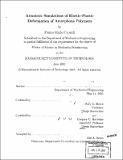Atomistic simulations of elastic-plastic deformation of amorphous polymers
Author(s)
Capaldi, Franco Mario, 1977-
DownloadFull printable version (8.936Mb)
Other Contributors
Massachusetts Institute of Technology. Dept. of Mechanical Engineering.
Advisor
Mary C. Boyce.
Terms of use
Metadata
Show full item recordAbstract
As the demand for polymers with superior properties increases, an understanding of the fundamental connections between the mechanical behavior and underlying chemical structure becomes imperative. In this work, the thermo-mechanical behavior and the molecular-level origins of plastic deformation of an amorphous glassy polymer were studied using atomistic simulations. Understanding of the molecular response will aid the development of physics-based continuum level models for these materials. A polyethylene-like molecular network was numerically constructed using a Monte Carlo algorithm and then subjected to uniaxial deformation over a wide range of strain rates and temperatures using Molecular Dynamics. The model exhibits many experimentally observed characteristics such as an initial elastic response followed by yield then volume preserving plastic deformation. The stress response was decomposed into intra and inter molecular components and analyzed throughout deformation. In the glassy regime, activation parameters were calculated in the context of the Eyring Model of flow in a solid. In addition, observations were made of the evolution of chain configuration and the correlation of transitions between dihedral angle states. Below the glass transition, dynamic heterogeneity is observed. It was also observed that mobility, as measured by the transitioning between dihedral angle states, increases during plastic deformation to levels observed at much higher temperatures under zero stress. At temperatures near the glass transition temperature, the mobility approaches levels of undeformed samples at the glass transition temperature.
Description
Thesis (S.M.)--Massachusetts Institute of Technology, Dept. of Mechanical Engineering, 2001. Includes bibliographical references (p. 121-125).
Date issued
2001Department
Massachusetts Institute of Technology. Department of Mechanical EngineeringPublisher
Massachusetts Institute of Technology
Keywords
Mechanical Engineering.